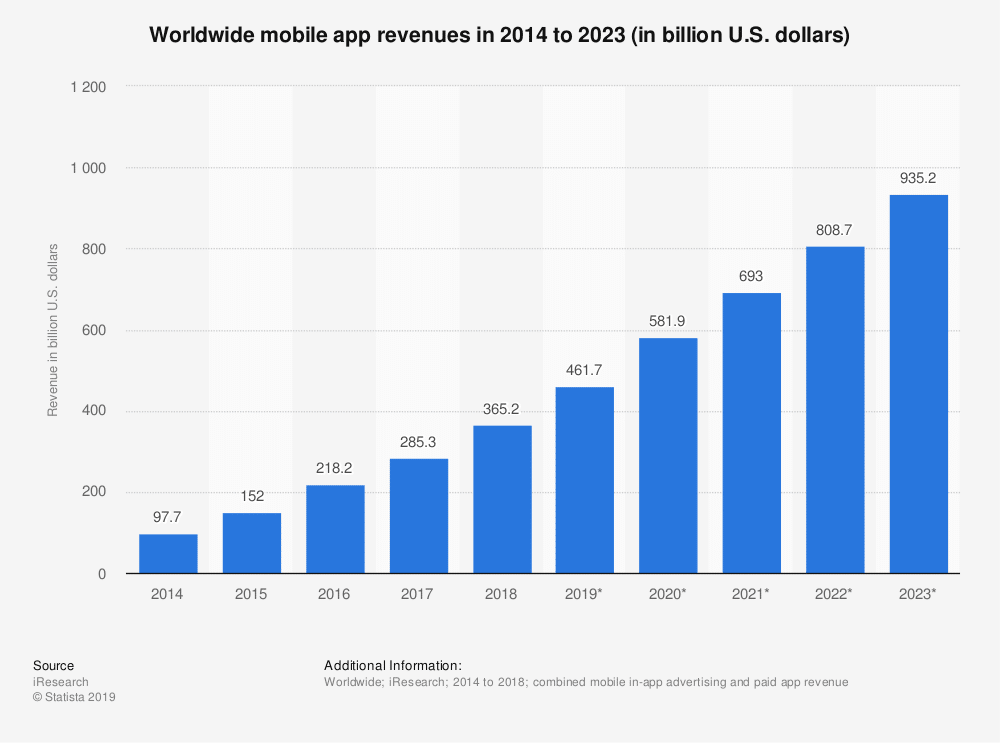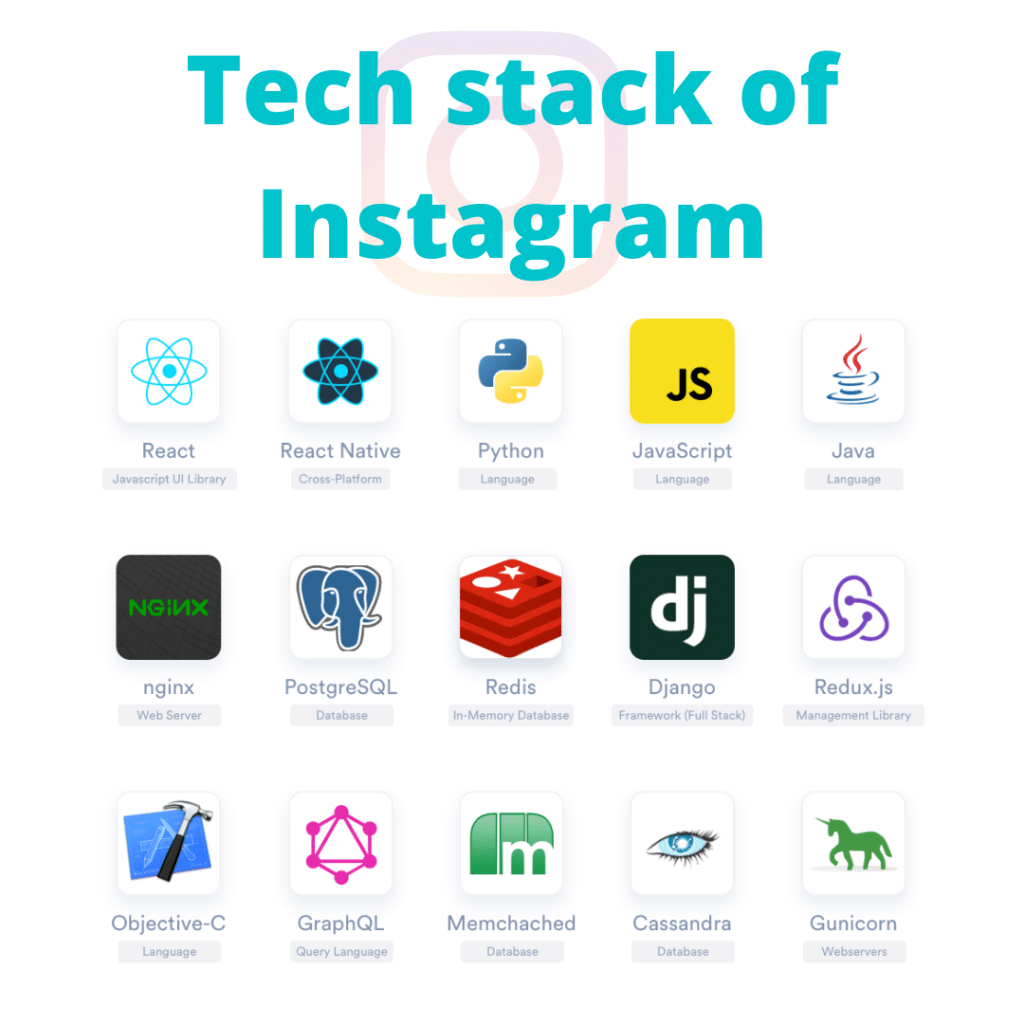The Best Tech Stack for Mobile App Development
August 13th, 2020
Mobile applications run the gamut from games to healthcare programs to valuable tools of all kinds. With the right app, you can find the best vegan restaurant in Prague or turn your phone into a flashlight, level, or a map. If you have any kind of business you definitely should think to develop a mobile app (if you haven’t yet)
It’s estimated that the mobile app development market will be worth around $935 billion by the year 2024. This indicates that there is still plenty of room in the market for innovative developers, creative ideas, and more streamlined programming. Of course, the question on most developer’s minds isn’t “what,” but “how.”

Technology Stacks: The Basics
Technology stacks, which are also called solutions stacks, tech infrastructures, and data ecosystems, are a combination of tech services, programming languages, and software needed to create and run an application. Whether the app is mobile or web-based, it essentially functions the same way.
The name “stack” comes from the way that each layer of an application is built on top of one another. Aside from being stacked, these program towers are also two-sided, boasting both client and server functionality, which is commonly known as the “front-end” and the “back-end.”
Now, in most cases, developers – along with the businesses that manage them – have a pretty clear vision of what their app will be used for, who will use it, what problem it will solve / service it will provide, and how it will earn the company money. However, when it comes to the technical end, including selecting the best tech stack for their needs, many of these companies will need assistance.
That’s where a reliable mobile software development company can be a huge help. Such companies not only have the skills and experience to match the developer’s needs with what’s actually available, but they can provide useful advice throughout the entire process.
A “Tech Stack Checklist”
When evaluating a tech stack, there are a number of questions that you want to ask yourself before committing. Your tech stack will be doing the majority of your work for you, so it’s common to consider this evaluation as you would an interview with a potential employee. When it comes to the list of attributes below, the more boxes you can check off, the more likely the tech stack will meet your needs.
- It is well-documented
- The community is very helpful.
- It is new, or there are multiple updated versions.
- It is owned and managed by a reputable company.
- My business can benefit from utilizing it.
- It has a large “ecosystem” of modules, plugins, etc.
- It can support a heavy processing load.
- I will always have access to my data.
- It comes with long-term support.
- It has a straightforward update and migration process.
- It can be learned relatively quickly.
- Its development was sponsored by big companies.
- The talent pool is large enough for recruitment.
- My company can handle the maintenance needs.
NOTE: If your product is similar to an app that already exists, you can do research on its backend technology to determine what stack might be right for you.

Factors to Consider When Selecting a Tech Stack
With the Mobile App market growing at an exponential rate, there is no shortage of technology stacks available to you. However, deciding which is the right one for your specific project requires quite a bit of work. If you want to have a working app that looks professional, functions well, is secure, and can be scaled as you grow, you need to consider the following factors:
- Your Project Type
Depending on your project’s nature and complexity, you might want to consider “going native.” This means coding your application in a specific programming language, such as Kotlin or Swift. This ensures fast performance and better reliability when compared to web and hybrid apps.
- The Type of Application
Obviously, the type of app you’re developing will have a huge impact on the tech stack you choose. This means considering the device on which the app will function, the user experience you’re aiming to provide, the network conditions under which it will run, the platform of choice, and how long you have before you go to market.
- Whether Your Idea Needs Validation
If you’re a startup and you just want to investigate whether or not your product is valid, you can engage your potential users and stay ahead of your competition with a cross-platform approach. In this case, React native would be an excellent choice, as it is quite inexpensive and offers you the ability to reuse code on a number of platforms. This will maximize the delivery time of your new app and give you a wide platform net with which to attract users.
- Release Date
“Time to Market” is one of the most critical aspects of maintaining a competitive advantage over other developers. If you’ve been handed a short deadline, consider a framework or programming language that includes plenty of ready-made solutions. These will help speed up common development tasks like social media integration, authentication, etc.
- The Budget
There’s no getting around the fact that money is the main motivator for developing apps. If your business can’t afford to invest in cross-platform development for both Android and iOS, you have to make some decisions. In this case, you can choose to hire an in-house JS team and move on to a React stack or select a solution like Xamarin. Both allow you to reuse your code, which will speed up your delivery time.

The Three Major Methods of App Development
When it comes to mobile app development, there are three major methods to consider, Native, Cross-Platform, and Hybrid. In this section, we’ll examine each (and their various sub-components) in more detail.
1. Native App Development
iOS Application Development: An Overview
Languages: Objective-C, Swift
Toolkit: Xcode
Objective-C has been the principal iOS coding language for years and remains widely-used in projects of all types. When working on a large legacy project that already features code written in this language, Objective-C makes perfect sense. It is also well-trained, so it’s easy to find developers who are experienced with it. Moreover, it has great compatibility with C++, allows for simple use of private APIs, and has a particularly-expressive code syntax.
Swift is much newer than Objective-C, but has been referred to by experts as “the future of mobile application programming.” If you’re building for iOS and want the best possible technology, Swift is much more robust and functional than Objective-C. It is also faster, more resistant to errors, offers clearer syntax – which increases code readability – and has a huge community you can access for support. Swift also lives up to its name by being much faster than the competition, making it much more cost-effective in the long run.
Android Mobile App Development: An Overview
Languages: Java, C++, Kotlin, C#
Tools: Android Developer Tools, Android Studio
Java is one of the most commonly-used (and oldest) coding languages. It’s often very easy to find developers who are familiar with it, and it usually comes with a variety of open-source libraries and tools you can use to speed up your time-to-market. Not only can Java be used as an app stack for Android, but it can also be applied to web development, Big Data, and more. Most development teams love Java for its security, ease of portability and scalability, multi-threaded capability, and wide range of functionality.
Kotlin is quite a bit newer than Java, but it has a great reputation among developers as a powerful and uncommonly-stable coding tool. It is also interoperable with Java, so teams can operate on mixed-language projects without issue. In terms of native Android Development, it is widely prized for its great security and fault tolerance, a large ecosystem of support, and clear, effective syntax, which uses around 35% fewer lines of code than Java.
C# is very similar to Java in a lot of ways, which makes it another great tool for Android-specific app development. However, it boasts a much easier and cleaner syntax than Java, which ends up making the coding process much more straightforward. With the addition of Xamarin, C# has been greatly improved in both versatility and functionality.
2. Cross-Platform App Development: An Overview
Tools: Flutter, Xamarin, React Native
When creating cross-platform mobile apps, the goal of most companies is to have them work well across many different operating systems. Doing so means writing a single codebase that is meant to be read by different OSs simultaneously. This is a popular solution for mobile app development because it offers faster coding and minimizes the budget needed for implementation and support. It also means companies get access to a larger audience, increasing their profit potential.
That said, every mobile tech stack has some negatives along with these positives. In almost all cases, compromises will need to be made regarding performance and user experience. In fact, even the best available cross-platform development can’t access each OS directly. Instead, they build a “bridge” to reach native modules, which can slow the operation of apps that use a lot of graphics.
React Native is a unique JavaScript library that utilizes TypeScript in order to reproduce the look and feel of native applications. It uses many of the same building blocks as most Android and iOS Solutions, but groups them via JavaScript and React. The result is a well-performing toolkit that’s quite close to native, boasts high-responsiveness and live reloading, and is platform-agnostic. Another benefit of React Native is its rich ecosystem and strong, helpful community of developers.
Flutter is one of the latest user interface kits on the market, allowing you to develop attractive software solutions for web, desktop systems, and mobile platforms from one single codebase. Originally introduced by Google, it includes a variety of built-in tools and widgets, as well as a hot reload feature, which allows developers to see code changes in real-time. Flutter also offers developers the ability to reuse existing Swift, Objective-C, or Java code when needed. In general, both business owners and developers appreciate Flutter for its fast time-to-market capabilities and smooth, nearly-native performance.
Xamarin gives developers the opportunity to share up to 96% of their code. This leaves just enough room for the reconfiguration of some user interface elements so that the apps can better function on individual platforms. With Xamarin, developers can use NET framework or C# language to write their code and then compile it into native Android or iOS binaries. They also have the ability to use MVC or MVVM design patterns in order to speed up development and facilitate debugging. With massive community support, Xamarin is a great way to produce functional, high-performing code.
In general, programming tools like React Native, Flutter, and Xamarin allow developers to reuse more of their code when designing across multiple platforms. This cuts overall development costs and dramatically shortens the time-to-market.
3. Hybrid App Development
Hybrid development tools use standard web tools and technology, including HTML5, CSS, and JavaScript. This code is then wrapped in a “native container” using a variety of different tools and shipped as a more or less standard app. Apps constructed in this manner tend to function like websites or browsers. One of the most common examples would be Untapped, the beer-rating app.
Cordova/PhoneGap is an open-source framework designed to run HTML and JavaScript applications within a unique native container. With JavaScript APIs, developers can access device functionality to control the device’s sensors and cameras. Luckily, developers aren’t forced to rely on CSS and HTML alone when it comes to building their UI, since PhoneGap supports a wide range of frameworks, including jQuery, Knockout.js, and AngularJS.
Ionic is based on the AngularJS framework, meaning it shares a number of its advantages. One of the most notable is the massive supporting community and the ability to make hybrid apps have a native look. Ionic is also able to reuse DOM elements in order to overcome most issues related to poor mobile performance.
By the way, KITRUM has been recognized as a Top App Development Companies in Florida.
Conclusion:
As more and more companies adopt mobile technologies, the global app market will continue to expand into the billions and beyond. As this happens, it will become increasingly important to find programmers that understand the app development process from all standpoints: technical, user, and business.
At KitRUM, we have nearly a decade of experience in the web and mobile engineering field. Beginning our journey as an Android and iOS development company, we have already created over 500 individual software solutions for companies all around the globe.
On top of that, our team also offers business technology consulting and mobile application development services in the areas of strategic planning, data analysis, DevOps, software testing, and design.








